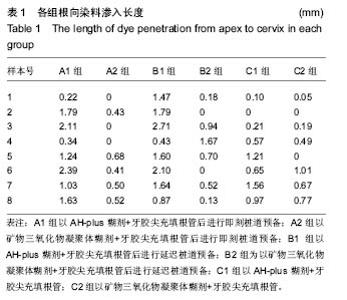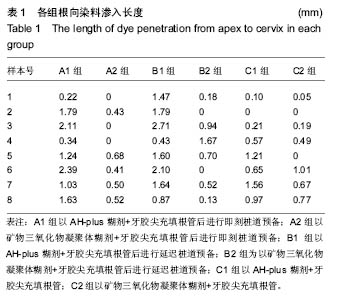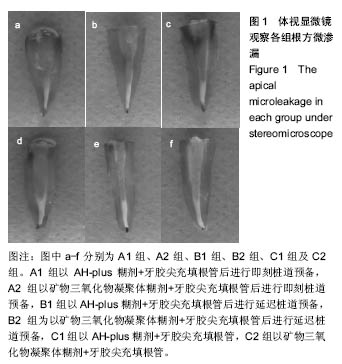Chinese Journal of Tissue Engineering Research ›› 2017, Vol. 21 ›› Issue (10): 1483-1488.doi: 10.3969/j.issn.2095-4344.2017.10.002
Previous Articles Next Articles
Influence of immediate or delayed post space preparation on the apical sealing ability of different root canal sealers
Lan Yu-yan, Huang Hai-xia, Fan Li-yuan, Pu Lin, Liu Min, Sun Li-bo
- Department of Prosthodontics, Laboratory of Orofacial Reconstruction and Regeneration, the Affiliated Stomatology Hospital of Southwest Medical University, Luzhou 646000, Sichuan Province, China
-
Received:2016-11-02Online:2017-04-08Published:2017-05-08 -
Contact:Pu Lin, Attending physician, Department of Prosthodontics, Laboratory of Orofacial Reconstruction and Regeneration, the Affiliated Stomatology Hospital of Southwest Medical University, Luzhou 646000, Sichuan Province, China -
About author:Lan Yu-yan, Master, Attending physician, Department of Prosthodontics, Laboratory of Orofacial Reconstruction and Regeneration, the Affiliated Stomatology Hospital of Southwest Medical University, Luzhou 646000, Sichuan Province, China
CLC Number:
Cite this article
Lan Yu-yan, Huang Hai-xia, Fan Li-yuan, Pu Lin, Liu Min, Sun Li-bo. Influence of immediate or delayed post space preparation on the apical sealing ability of different root canal sealers[J]. Chinese Journal of Tissue Engineering Research, 2017, 21(10): 1483-1488.
share this article
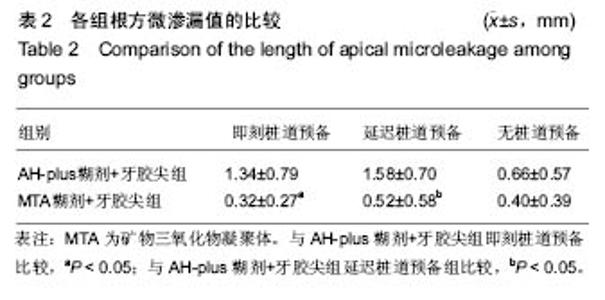
2.2 统计学分析结果 对6组的数据进行单因素方差分析。两种糊剂根管充填后根方微渗漏不同,统计分析结果表明,A1组和B1组,A2组和B2组根方微渗漏值比较差异均无显著性意义(P > 0.05),说明两种充填糊剂充填后,组内即刻桩道预备和延迟桩道预备之间根方微渗漏值无差异(P > 0.05);A2组与A1组,B2组与B1组根方微渗漏值之间有统计学差异(P <0.05);C2组根方微渗漏值小于C1组,但差异无显著性意义(P > 0.05)。说明无论是即刻桩道预备还是延迟桩道预备,以MTA为充填糊剂的根管根方微渗漏值均比以AH-plus为充填糊剂充填的根管根方微渗漏小(P < 0.05),见表2。"
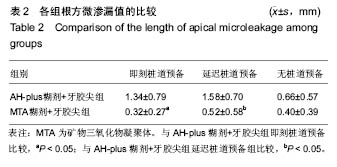
| [1]Muliyar S,Shameem KA,Thankachan RP,et al.Microleakage in endodontics.J Int Oral Health.2014;6(6):99-104.[2]Ahuja L,Jasuja P,Verma KG,et al.A Comparative Evaluation of Sealing Ability of New MTA Based Sealers with Conventional Resin Based Sealer: An In-vitro Study.J Clin Diagn Res.2016; 10(7):ZC76-79.[3]Chohan H,Dewan H,Annapoorna BM,et al.Comparative evaluation of sealing ability of glass ionomer-resin continuum as root-end filling materials: An in vitro study. J Int Soc Prev Community Dent.2015;5(6):488-493.[4]Mokhtari H,Shahi S,Janani M,et al.Evaluation of apical leakage in root canals obturated with three different sealers in presence or absence of smear layer.Iran Endod J. 2015;10(2): 131-134.[5]李秀丽,杨玥,侯本祥,等.4种根管封闭剂根尖封闭效果的体外实验研究[J].北京口腔医学,2014,22(4):200-203.[6]伍廷芸,黄扬睿,朱友家,等.不同根充材料对于根尖横剖面封闭性能的效果评价[J].武汉大学学报(医学版), 2015,35(1): 135-139.[7]Patil P,Rathore VP,Hotkar C,et al.A comparison of apical sealing ability between GuttaFlow and AH plus: An in vitro study.J Int Soc Prev Community Dent.2016;6(4):377-382.[8]沈英.热牙胶温度对AH-plus根管糊剂所产生的根尖微渗透的研究[J].全科医学临床与教育,2015,13(5):533-535.[9]Pawar SS,Pujar MA,Makandar SD.Evaluation of the apical sealing ability of bioceramic sealer, AH plus & epiphany: An in vitro study.J Conserv Dent. 2014;17(6):579-582.[10]Patni PM,Chandak M,Jain P,et al.Stereomicroscopic Evaluation of Sealing Ability of Four Different Root Canal Sealers- An invitro Study.J Clin Diagn Res. 2016;10(8): ZC37-39. [11]Sultana M,Musani MA,Ahmed IM.An in-vitro comparative study for assessment of apical sealing ability of Epiphany/AH Plus sealer with Resilon/gutta-percha root canal filling materials.J Int Soc Prev Community Dent.2016;6(4):321-326.[12]Carnio J,Neiva RF.Mineral Trioxide Aggregate and Subepithelial Connective Tissue Graft for Treatment of latrogenic Gingival Recession: Long-Term Results.Int J Periodontics Restorative Dent.2014;34(1):71-77. [13]穆云静,屈铁军,程小刚,等.4种根管封闭剂体外细胞毒性的比较[J].牙体牙髓牙周病学杂志,2014,24(2):90-94.[14]Bayram HM,Saklar F,Bayram E,et al.Determination of the Apical Sealing Abilities of Mineral Trioxide Aggregate, Portland Cement, and Bioaggregate After Irrigation with Different Solutions.J Int Oral Health.2015;7(6):13-17.[15]de Almeida J,Pimenta AL,Felippe WT.A laboratory assessment of bacterial leakage in MTA apical plugs exposed to phosphate-buffered saline.Acta Odontol Latinoam. 2015; 28(2):144-148. [16]Amezcua O,Gonzalez ÁC,Borges ÁH,et al.Sealing ability of root-end filling materials.J Contemp Dent Pract. 2015; 16(3): 210-214.[17]Jain A,Ponnappa KC,Yadav P,et al.Comparison of the Root End Sealing Ability of Four Different Retrograde Filling Materials in Teeth with Root Apices Resected at Different Angles-An Invitro Study.J Clin Diagn Res.2016;10(1): ZC14-17.[18]Metzger Z,Abramovitz R,Abramovitz L,et al.Correlation between remaining length of root canal fillings after immediate post space preparation and coronal leakage.J Endod. 2000;26(12):724-728.[19]Rahimi S,Shahi S,Nezafati S,et al.In vitro compar-ison of three different lengths of remaining gutta-percha for establishment of apical seal after post-space preparation. J Oral Sci.2008;50(4):435-439.[20]Mattison G,Delivanis P,Thacker R,et al.Effect of post preparation on the apical seal.J Prosthet Dent.1984;51(6): 785-789.[21]Kwan EH, Harrington GW. The effect of immediate post preparation on apical seal. J Endod. 1981;7(7):325-329.[22]Abramovitz I, Tagger M, Tamse A, Metzger Z. The effect of immediate vs. delayed post space preparation on the apical seal of a root canal filling: a study in an increased-sensitivity pressure-driven system. J Endod. 2000;26(8):435-439.[23]Grecca FS, Rosa AR, Gomes MS.Effect of timing and method of post space preparation on sealing ability of remaining root filling material: in vitro microbiological study. J Can Dent Assoc. 2009; 75(8):583.[24]Keles A,Ahmetoglu F,OcaK MS,et al.Comparative analysis of three different filling techniques and the effects of experimental internal resorptive cavities on apical microleakage. Eur J Dent.2014;8(1):32-37.[25]王青青,唐宇英.根管预备型号与充填温度对热牙胶充填根尖微渗漏的影响[J].第三军医大学学报,2015,37(7):684-688.[26]王淼,吴洪斌,宋雪莲,等.三种根管充填技术根尖封闭能力比较研究[J].中国实用口腔科杂志,2013,6(6):360-363.[27]Machado MB,Alves Morgan LF,et al.Effects of immediate and delayed intraradicular preparation on bond strength of fiber posts.Indian J Dent Res.2015;26(3):244-247. [28]白雪,任国亨,姜志清.根管不同长度充填后即刻与延迟桩道预备对根尖微渗漏的影响[J].中国实用口腔科杂志, 2013,6(6): 367-369.[29]Lyons WW,Hartwell GR,Stewart JT,et al.Comparison of coronal bacterial leakage between immediate versus delayed post-space preparation in root canals filled with Resilonepiphany. Int Endod J.2009;42(3):203-207.[30]曹小丽,陈璟,李荣华,等.即刻与延迟桩道预备对不同根管充填材料根尖封闭性的影响比较[J].河北医药,2013,35(7):994-995.[31]Dhaded N,Uppin VM,Dhaded S,et al. Evaluation of immediate and delayed post space preparation on sealing ability of Resilon-Epiphany and Gutta percha-AH plus sealer. J Conserv Dent.2013;16(6):514-517.[32]杜瑞钿,刘森庆,耿发云,等.纤维桩桩道预备时机对根尖微渗漏影响的体外对比研究[J].口腔疾病防治,2016,24(9):515-518.[33]湛倩倩,魏昕.三氧化矿物凝聚体的性能及其研究进展[J].口腔医学,2016,36(8):761-764.[34]王敏永,刘鹤,李盛林,等.三氧化矿物凝聚体对乳、恒牙牙髓细胞增殖和分化影响的比较[J]. 华西口腔医学杂志, 2015,33(1): 75-79. [35]周海燕,潘央央,夏可可,等.MTA和Ca(OH)2用于年轻恒牙活髓切断术疗效的系统评价[J].口腔医学研究杂志, 2015,31(12): 1223-1227.[36]Kumar A,Yadav A,Shetty N.One-step apexification using platelet rich fibrin matrix and mineral bioxide aggregate apical.Indian J Dent Res.2014;25(6):809-812.[37]Metgud SS,Shah HH,Hiremath HT,et al.Effect of post space preparation on the sealing ability of mineral trioxide aggregate and Gutta-percha: A bacterial leakage study.J Conserv Dent. 2015;18(4):297-301.[38]Khademi AA,Shekarchizade N.Evaluation of coronal microleakage of mineral trioxide aggregate plug-in teeth with short roots prepared for post placement using bacterial penetration technique.Indian J Dent Res.2016;27(3):295-299.[39]李浩渤,杜勇.矿物三氧化物凝聚体根尖屏障后的根尖微渗漏[J].中国组织工程研究, 2016,20(3):382-386.[40]Hakki SS,Bozkurt SB,Hakki EE,et al.Effects of Mineral Trioxide Aggregate on Cell Survival, Gene Expression Associated with Mineralized Tissues,and Biomineralization of Cementoblasts.J Endod.2009;35(4):513-519.[41]Alsulaimani RS.Single-visit endodontic treatment of mature teeth with chronic apical abscesses using mineral trioxide aggregate cement: a randomized clinical trial.BMC Oral Health. 2016;16(1):78.[42]周铸民,束煌,彭兆伟,等.3种材料用于根尖诱导成形术的疗效研究[J].国际医药卫生导报,2012,18(6):784-786.[43]李冬霞,吕晶,汪正文.MTA应用于切髓术、根尖诱导成形术疗效观察[J].中国医药导报,2011,8(12):49-51.[44]Reyhani MF,Ghasemi N,Rahimi S,et al.Apical microleakage of AH Plus and MTA Fillapex® sealers in association with immediate and delayed post space preparation: a bacterial leakage study.Minerva Stomatol.2015;64(3):129-134. |
| [1] | Yao Xiaoling, Peng Jiancheng, Xu Yuerong, Yang Zhidong, Zhang Shuncong. Variable-angle zero-notch anterior interbody fusion system in the treatment of cervical spondylotic myelopathy: 30-month follow-up [J]. Chinese Journal of Tissue Engineering Research, 2022, 26(9): 1377-1382. |
| [2] | An Weizheng, He Xiao, Ren Shuai, Liu Jianyu. Potential of muscle-derived stem cells in peripheral nerve regeneration [J]. Chinese Journal of Tissue Engineering Research, 2022, 26(7): 1130-1136. |
| [3] | Zhang Jinglin, Leng Min, Zhu Boheng, Wang Hong. Mechanism and application of stem cell-derived exosomes in promoting diabetic wound healing [J]. Chinese Journal of Tissue Engineering Research, 2022, 26(7): 1113-1118. |
| [4] | He Yunying, Li Lingjie, Zhang Shuqi, Li Yuzhou, Yang Sheng, Ji Ping. Method of constructing cell spheroids based on agarose and polyacrylic molds [J]. Chinese Journal of Tissue Engineering Research, 2022, 26(4): 553-559. |
| [5] | He Guanyu, Xu Baoshan, Du Lilong, Zhang Tongxing, Huo Zhenxin, Shen Li. Biomimetic orientated microchannel annulus fibrosus scaffold constructed by silk fibroin [J]. Chinese Journal of Tissue Engineering Research, 2022, 26(4): 560-566. |
| [6] | Chen Xiaoxu, Luo Yaxin, Bi Haoran, Yang Kun. Preparation and application of acellular scaffold in tissue engineering and regenerative medicine [J]. Chinese Journal of Tissue Engineering Research, 2022, 26(4): 591-596. |
| [7] | Kang Kunlong, Wang Xintao. Research hotspot of biological scaffold materials promoting osteogenic differentiation of bone marrow mesenchymal stem cells [J]. Chinese Journal of Tissue Engineering Research, 2022, 26(4): 597-603. |
| [8] | Shen Jiahua, Fu Yong. Application of graphene-based nanomaterials in stem cells [J]. Chinese Journal of Tissue Engineering Research, 2022, 26(4): 604-609. |
| [9] | Zhang Tong, Cai Jinchi, Yuan Zhifa, Zhao Haiyan, Han Xingwen, Wang Wenji. Hyaluronic acid-based composite hydrogel in cartilage injury caused by osteoarthritis: application and mechanism [J]. Chinese Journal of Tissue Engineering Research, 2022, 26(4): 617-625. |
| [10] | Li Hui, Chen Lianglong. Application and characteristics of bone graft materials in the treatment of spinal tuberculosis [J]. Chinese Journal of Tissue Engineering Research, 2022, 26(4): 626-630. |
| [11] | Gao Cangjian, Yang Zhen, Liu Shuyun, Li Hao, Fu Liwei, Zhao Tianyuan, Chen Wei, Liao Zhiyao, Li Pinxue, Sui Xiang, Guo Quanyi. Electrospinning for rotator cuff repair [J]. Chinese Journal of Tissue Engineering Research, 2022, 26(4): 637-642. |
| [12] | Guan Jian, Jia Yanfei, Zhang Baoxin , Zhao Guozhong. Application of 4D bioprinting in tissue engineering [J]. Chinese Journal of Tissue Engineering Research, 2022, 26(3): 446-455. |
| [13] | Liu Jiali, Suo Hairui, Yang Han, Wang Ling, Xu Mingen. Influence of lay-down angles on mechanical properties of three-dimensional printed polycaprolactone scaffolds [J]. Chinese Journal of Tissue Engineering Research, 2022, 10(16): 2612-2617. |
| [14] | Huang Bo, Chen Mingxue, Peng Liqing, Luo Xujiang, Li Huo, Wang Hao, Tian Qinyu, Lu Xiaobo, Liu Shuyun, Guo Quanyi . Fabrication and biocompatibility of injectable gelatin-methacryloyl/cartilage-derived matrix particles composite hydrogel scaffold [J]. Chinese Journal of Tissue Engineering Research, 2022, 10(16): 2600-2606. |
| [15] | Fang Xiaoyang, Tang Tian, Wang Nan, Qian Yuzhang, Xie Lin. Repair and regenerative therapies of the annulus fibrosus [J]. Chinese Journal of Tissue Engineering Research, 2022, 26(10): 1582-1587. |
| Viewed | ||||||
|
Full text |
|
|||||
|
Abstract |
|
|||||
